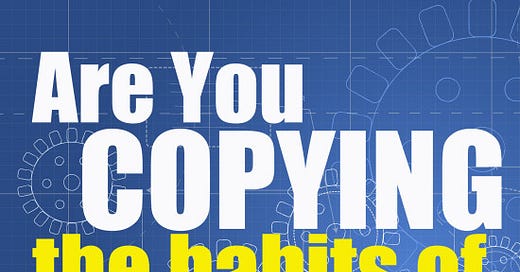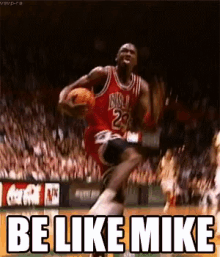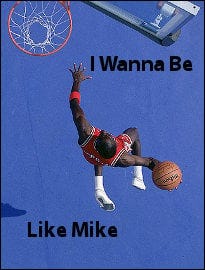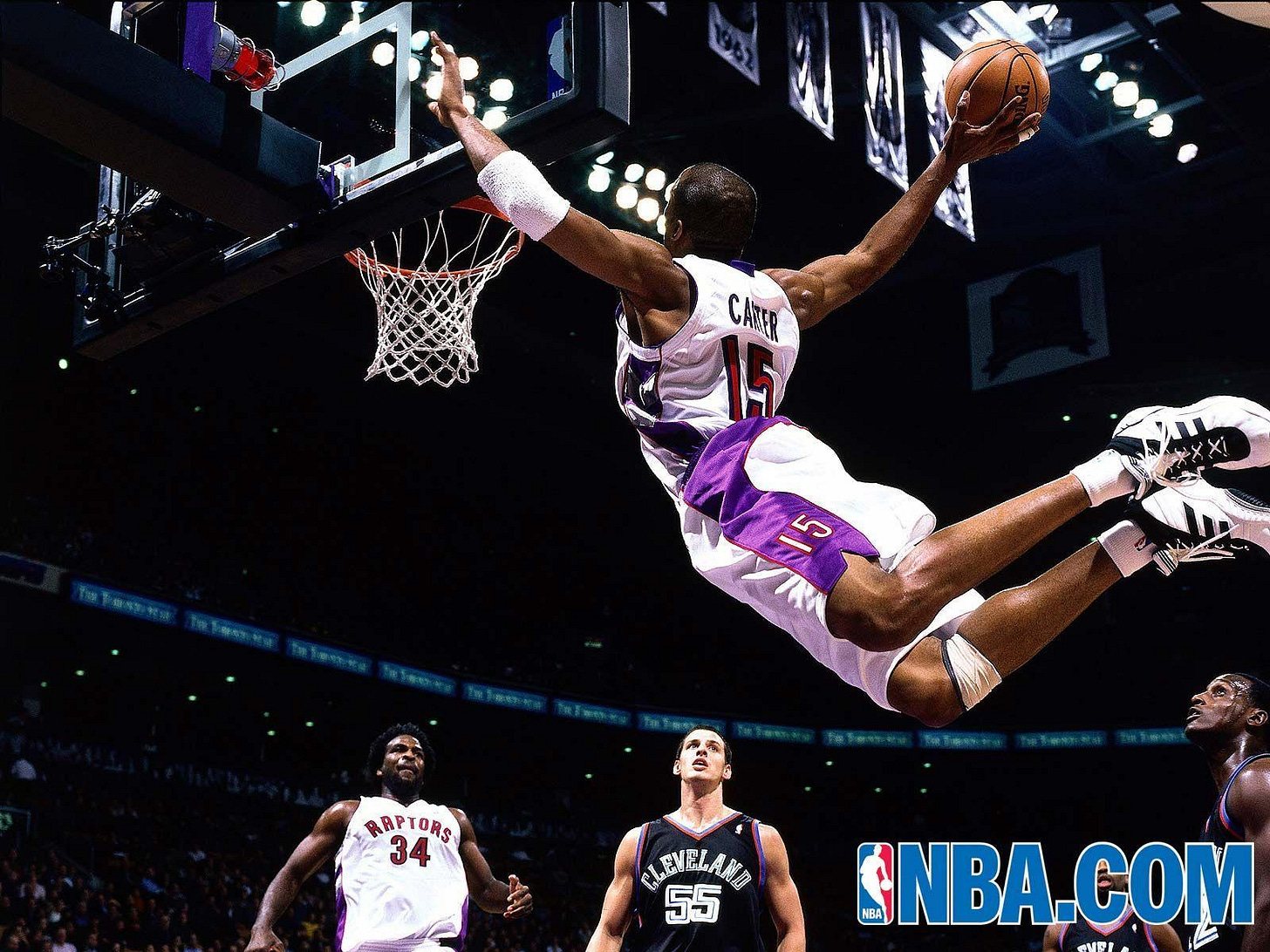Copy Your Way to Success
The concept of innovation has been all the rage in 21st Century America. No matter where one looks – books, media, or corporate board rooms – there is a focus on this concept. And for good reason. Innovation is critical to progress.
I would like to make the claim, however, that copying is at least as important as innovating. In a previous article, I made the claim that copying successful organizations and societies is a key factor in How Progress Works.
Today I want to make the case that this is equally true for individuals. This is particularly true for those lower-income or young people who are just starting out.
No matter what domain you seek to enter, there is one Golden Rule of Success: Copy the Successful.
It does not matter whether you want to be an athlete, artist, business leader, political leader, doctor, farmer, or welder. The simplest way to get better at something is to copy those who are most successful in the field. By copying the best, you are effectively learning from all the trial-and-error attempts made by those who came before you.
Be Like Mike
So let’s say that you want to dunk a basketball like Michael Jordan. What should you do?
In the 1990s Nike wanted you to believe that “Its’ Gotta Be the Shoes.” The famous Nike advertising campaign was taking advantage of the normal human behavior of copying other people in fashion trends. This kind of copying may seem irrational, but it is based on behavior that is firmly rooted in human behavior. And that copying behavior has been key to the success of the human species.
Why Copy Others?
In a fascinating article entitled “Why Copy Others?” (you can read a short summary in my library of online book summaries) a research team documented a computer simulation designed to test the most effective learning strategies. The researchers asked experts to write algorithms that would compete against each other in a computer tournament that consisted of 10,000 rounds. The entries consisted of various blends of learning strategies, including:
trial-and-error learning
copying
executing on a decision.
At the end of each round, successful algorithms “lived” (i.e. they went onto the next round), while unsuccessful algorithms “died” (they were dropped from the tournament). In this way, the researchers created a simulated evolutionary process with each player using different strategies.
So which strategy won? Those who relied heavily on copying what had worked in the previous round (or what the researchers called “social learning”) repeatedly won.
The researchers did not expect this result. No matter how many times they ran the simulation, they got roughly the same results. The variations in outcome between the algorithms were mainly dependent upon the length of time spent learning from others and the timing of when enough information had been gathered before actually making a decision.
This finding has been replicated in many other studies and domains of research. Copying really works.
But how do you know what to copy?
Is it better to copy only the most successful, or is it better to copy a broader range of successful people?
Copy multiple successful examples
Additional experiments by Joseph Henrich (who has made stellar contributions to the field) show that copying multiple people is better than copying one person. Henrich and his assistant asked inexperienced students to recreate an image using image-editing software. Those students then passed on their image and instructions to the next set of students. Some of the students received the image and instructions from one student in the previous round; other students received the same from five different students.
The results were compelling. Students who received instructions from only one person hardly improved their skills at all. Among students who received instructions from five different students, however, the average skill increased dramatically (by 20-80%). Every student who received instructions from five people outperformed even the best student who received instructions from only one person.
This makes sense. As Henrich speculates, students who received instructions from five others were not just mindlessly copying. They were:
comparing the instructions from each of the five,
looking for commonalities among those who were most successful.
paying particular attention to the instructions written by the student who had done the best in the previous round.
By copying five people instead of one, they were effectively recombining the lessons learned from five different sources to create a new strategy that they could then try in the next round. The recombinations that succeeded best in the subsequent round were then given the most weight by the next round of students. So in each round students inherited the learning from students who had participated in earlier rounds.
Just as innovators recombine successful simple technologies, skills, and organizations to create more complex technologies, skills, and organization, copiers do the same. As one delves into the concepts more deeply, the line between innovating and copying becomes increasingly blurred. Innovation requires copying, and copying involves at least some innovation (mainly by making decisions as to which ideas to copy).
This leads to a valuable lesson for us all. The fastest and most effective means of success is to:
Copy the successful.
Ideally, copy a wide variety of successful people, and then figure out what they are doing in common.
When in doubt, err towards copying the most successful person.
Then once you have become one of those successful people in your field, you can start focusing on innovating something new. Only once you have exhausted all the lessons learned by previous generations of successful people is it worth spending the time and energy to innovate.
To summarize, innovating and copying the most successful innovations are critical factors in promoting individual success.
But will copying Michael Jordan and other NBA players lead to similar results? That is the subject of my next article.
Most of the above is an excerpt from my second book From Poverty to Progress: Understanding Humanity’s Greatest Achievement. You can purchase discounted copies of my book at my website, or pay full prize at Amazon.
Other books in my “From Poverty to Progress” book series:
See more articles on Upward Mobility:
Why Progress and Upward Mobility should be the goal, not Equality
The Pathway to Success (first of three articles in series)













Wonderful post today, Michael.
A year later, here are some additional thoughts or questions…
You wrote: “By copying five people instead of one, they were effectively recombining the lessons learned from five different sources to create a new strategy that they could then try in the next round. The recombinations that succeeded best in the subsequent round were then given the most weight by the next round of students. So in each round students inherited the learning from students who had participated in earlier rounds.”
Random Thoughts
1) The similarities to biological sexual recombination are striking.
2) Of course, recombination is a form of innovation and variation. It is creating new patterns by using old solutions combined in new ways.
3) By learning from 5 people prior to copying, they are also dramatically increasing the learning time, so this could also be contributing
4) By seeing 5 examples, the shared or core foundational principles would probably stand out.
5) By seeing 5 examples, the copier could also use benchmarking to select which alternatives are best
6) As you wrote: “the line between innovating and copying becomes increasingly blurred.” I think this gets to the heart of cumulative improvements over time. The process Henrich shares leads both to more accurate copying, and smarter, more efficient forms of innovation and it does so at the same time.
Very insightful.